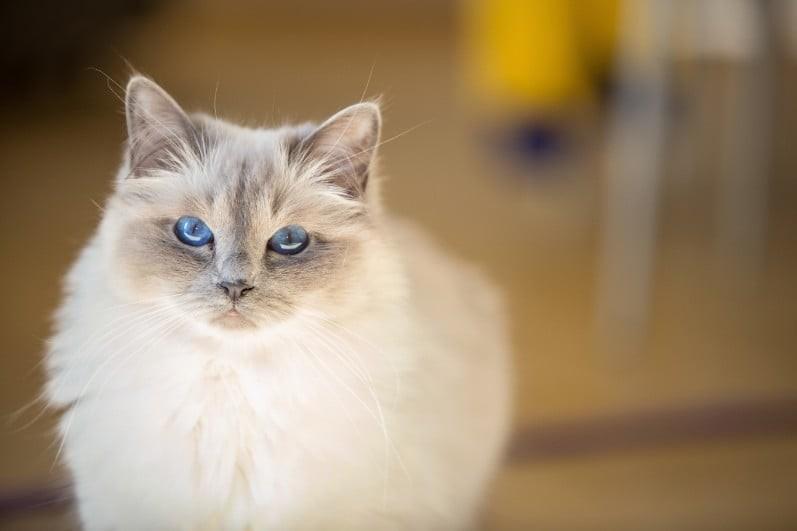
Birmans
The Birman is a slightly long haired, color-pointed cat, known for its deep-blue eyes and contrasting white-glove like paws. As the name suggests, the cat does have its origin in the northern parts of Burma.
Breed Profile
Height
8 – 10
Inches
Weight
8 – 12
Pounds
Life Span
12 – 16
Years
Health
health
Feline Hypertrophic Cardiomyopathy (HCM)
What is it?:
It is the most common form of a heart disease. It causes the walls of the heart muscle to thicken and can cause the heart to increase in size
Clinical signs
Rapid breathing, open-mouthed breathing and lethargy
Treatment
Oral and injected medication prescribed by your vet can help manage HCM
Eligible vet bill
$2,200
*Hypothetical reimbursement examples illustrate reimbursement of an eligible vet bill at the noted reimbursement rate, assuming the annual deductible had already been satisfied and the annual coverage limit has not yet been met. Annual deductible, co-insurance, benefit and coverage limits, and exclusions may apply. Eligibility may vary. Visit https://spotpet.com/sample-policy for full terms. For Canada enrollments only, reimbursement rate is based on the pet's age.
Personality
Affectionate
Birman cats are one of the most affectionate breeds out there and tend show love to their parents in various forms
Friendly
They have an easy-going nature which makes it best suited for families with children or other pets
Cuddly
Who wouldn’t like to cuddle that beautiful silky coat of Birman cats? Luckily, even they love to be petted. They are also known to extend their love to other pets in the house. So, don’t be surprised if your cat is found cuddling with your doggo someday. (They are just friends)
Lifetime Care
Coat
Birmans have a medium-long silk like textured coat with a missing undercoat
Colors
The breed comes in a variety of colors including seal, blue, lilac, white, black and many more
Hypoallergenic
No
Grooming
Comb and brush grooming once a week is required
Training
Although laid back at times, Birmans can be trained to walk on a leash, climbing towers, playing with puzzles, etc.
There are stories that these cats were a companion to the temple priests and thus received the magnificent blue eyes as a reward for their devotion. It was the goddess Tsun-Kyan-Kse that gifted these cats for their loyalty towards the priests. And since then, Birmans are often used as a gesture of thanks to those who show their devotion to these temples. There was also a time when only a couple of the Birmans survived due to the World War 2. A lot of hard work was done to keep the breed alive. The medium-sized, rectangular breed is often used for cross-breeding given their glamorous looks and their trademarked contrasting pure-white symmetrical gloves on each paw.
Birman Cat: Introduction to the Breed
Adding any new pet to your family is a big decision. So it becomes very important that you take the time to research the breed that matches your vibe, personality and lifestyle. Think through the traits you’d like in a cat, and the ones you’d want to avoid. Here are a few things you need to know about the Birman breed.
Birman Cats are generally:
Sociable and Dependent
Family Cat
Affectionate and cuddly
Never aggressive
Birmans are best suited for –
First time cat owners
Families with kids
Relaxed home environment
If you are first time cat owner or want to add a companion to your existing pets or kids, the Birman is a great choice. They blend easily into the family and also do not require a lot of care.
On the other hand, they do require your attention. They might seem lazy at times but otherwise they are very active at home and they love playing games. But don’t worry if you’re planning a day out with your friends, the Birmans will stay peacefully at your house alone all day.
What should your Birman Cat eat?
Birmans are comparatively more of a delicate breed that necessitates the best cat food in order to stay healthy and thrive. So the parent must make sure the food is
High in protein
Low in carbohydrates
Moderate in fats
The food list can include
Salmon (without bones)
Chicken (without any oil, garlic or onion seasoning)
Oatmeal
Bananas
Bread (slightly baked and yeast free)
Blueberries (avoid if the weight of your Birman is increasing)
Turkey
Peas
Fresh fruits and carrots
What should your Birman Cat NOT eat?
The basic requirement is to not add any fatty food to the cat bowl of your Birman. The items not to include in its diet include
Dried fish
Fragrant spicy meat
Squid and shellfish
Birds and fish bones
Conclusion
One of the most affectionate cats, perfect for first time cat owners and families with young children are things that nicely describe a Birman cat. Also, if you are not planning to spend a lot on a pet’s daily and lifetime care, Birmans would be a great choice for you given its low maintenance nature.
Sources:


